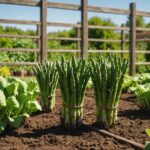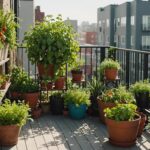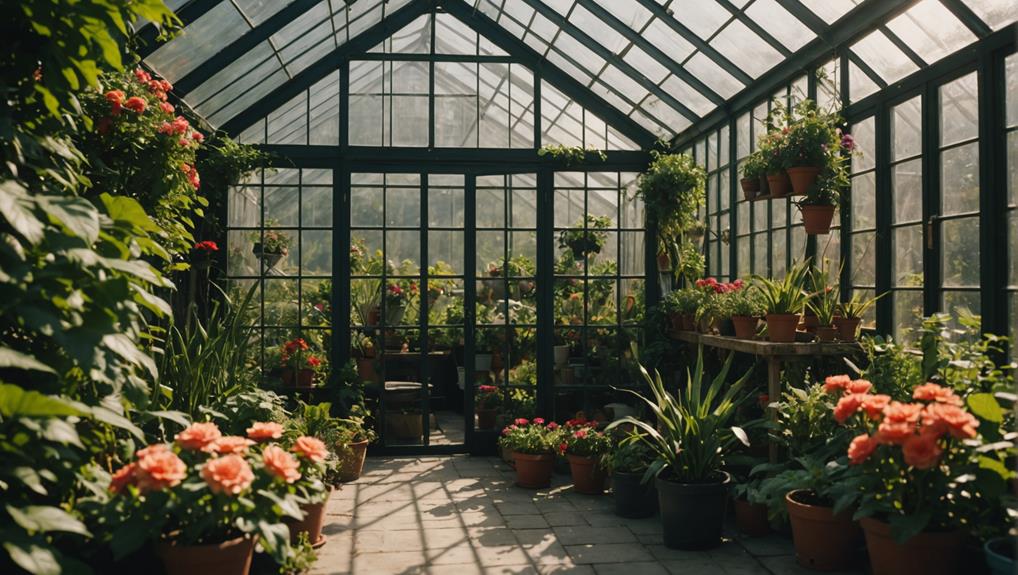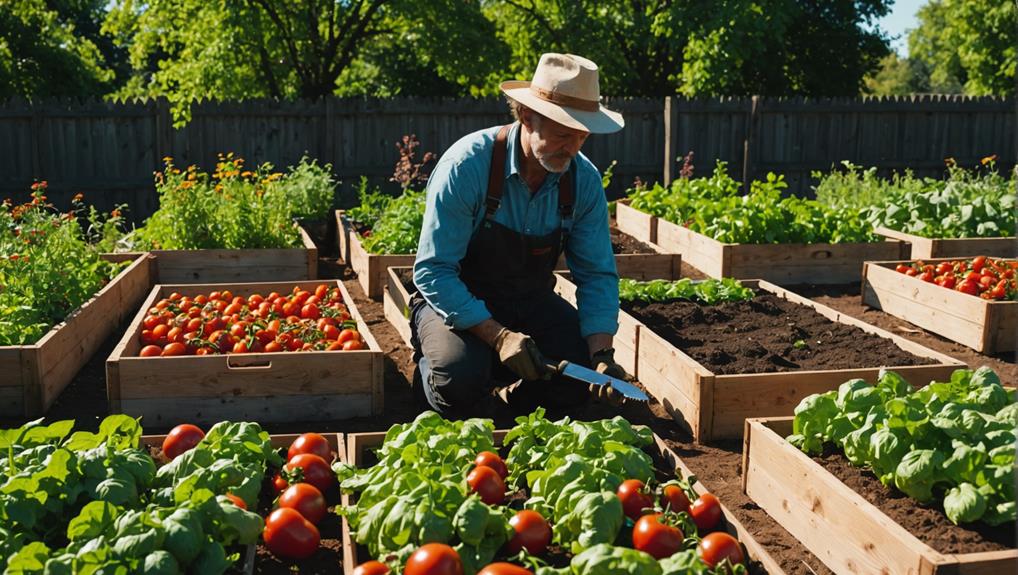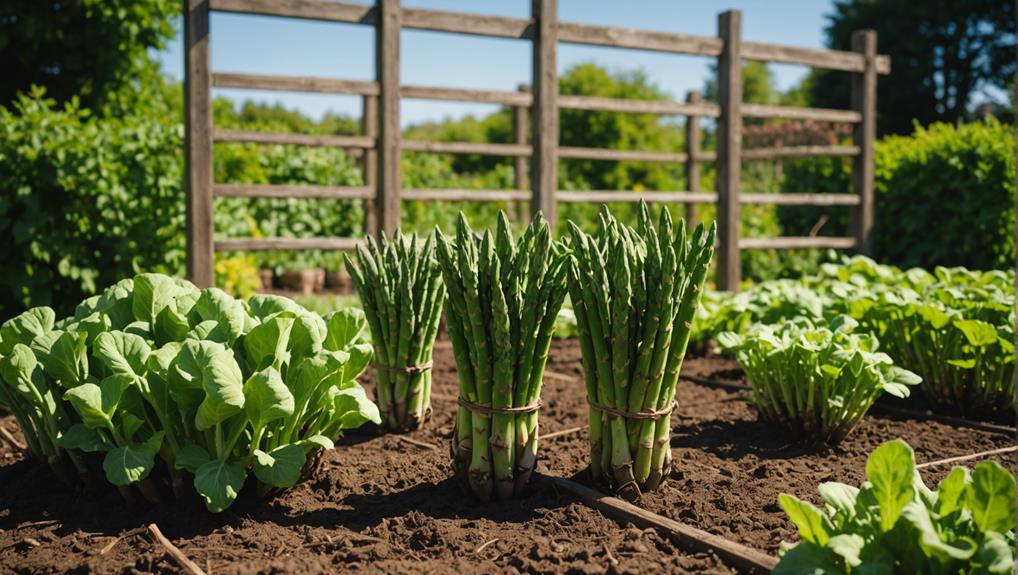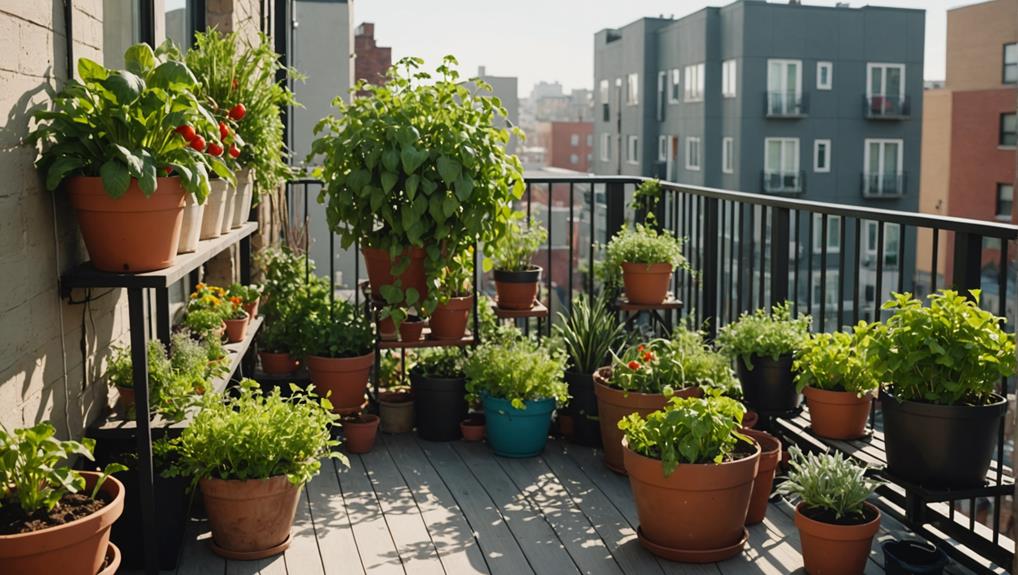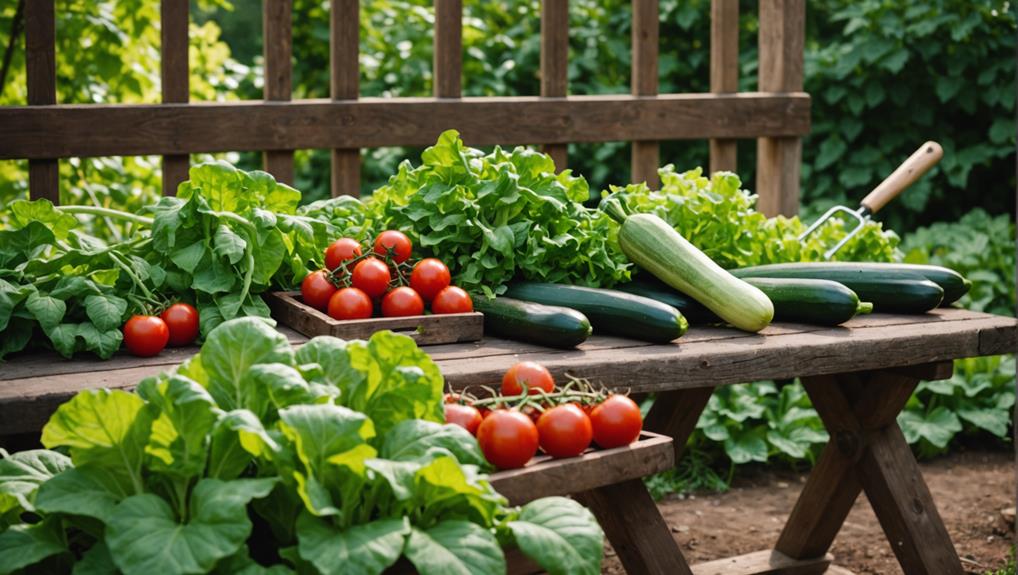As an Amazon Associate I earn from qualifying purchases.
To build a DIY greenhouse for year-round gardening, start by choosing a sunny, south-facing location. Gather essential materials like treated wood for framing and clear plastic sheeting for covering. Design the layout with good airflow and insulation, particularly on the north wall, to maintain stable temperatures. Confirm a solid foundation and consider pathways for easy access. Incorporate proper ventilation with roof vents or side openings to regulate humidity. Finally, keep up with seasonal maintenance tasks to foster a healthy environment for your plants. There's more to explore on optimizing your greenhouse for impressive growing results!
Choosing the Right Location
When you choose the right location for your greenhouse, make sure it faces south to capture at least six hours of sunlight each day. This sun exposure is critical for maximizing growth and ensuring your plants thrive throughout the seasons. Avoid placing your greenhouse under the shade of trees or structures, as this can limit light and lead to messy leaf debris that blocks sunlight.
Proximity to a reliable water source is necessary, too. You want to easily water your plants without the hassle of long hoses or trips back and forth. Consider also your access to electrical supply for heating needs during colder months.
Don't overlook air circulation either; it's essential for temperature control and preventing mold. Assess the wind exposure at your greenhouse site. You'll want to shield it from prevailing winds that could destabilize temperatures and compromise your structure's integrity.
Utilizing digital tools, like Google Project Sunroof, can help you analyze sunlight and shade patterns, guiding you to the ideal spot for your greenhouse. This careful planning sets the stage for a flourishing garden, giving you the freedom to grow year-round.
Essential Materials and Tools
Choosing the right materials and tools is vital for building a durable and efficient greenhouse that meets your gardening needs year-round. Start with your framing materials, selecting from options like treated wood for a natural feel, galvanized steel for strength, aluminum for lightweight durability, or cost-effective PVC pipes. Each has its pros and cons, so pick what fits your vision.
Next, consider your covering materials. Clear plastic sheeting is inexpensive, but polycarbonate panels offer better strength and insulation. If you want an aesthetic touch, tempered glass is an option, though it requires careful handling.
Don't forget your insulation options! Bubble wrap, foam panels, or even recycled materials can help maintain warmth in cooler months, especially if you're in a chillier climate.
To get started, gather necessary tools like a shovel for site prep, a level to guarantee your frame is straight, and a power drill to secure your materials. Additional supplies such as sealant for attaching coverings, furring strips for grow lights, and drainage materials will also be vital. With the right materials and tools, you're on your way to a thriving greenhouse!
Designing Your Greenhouse
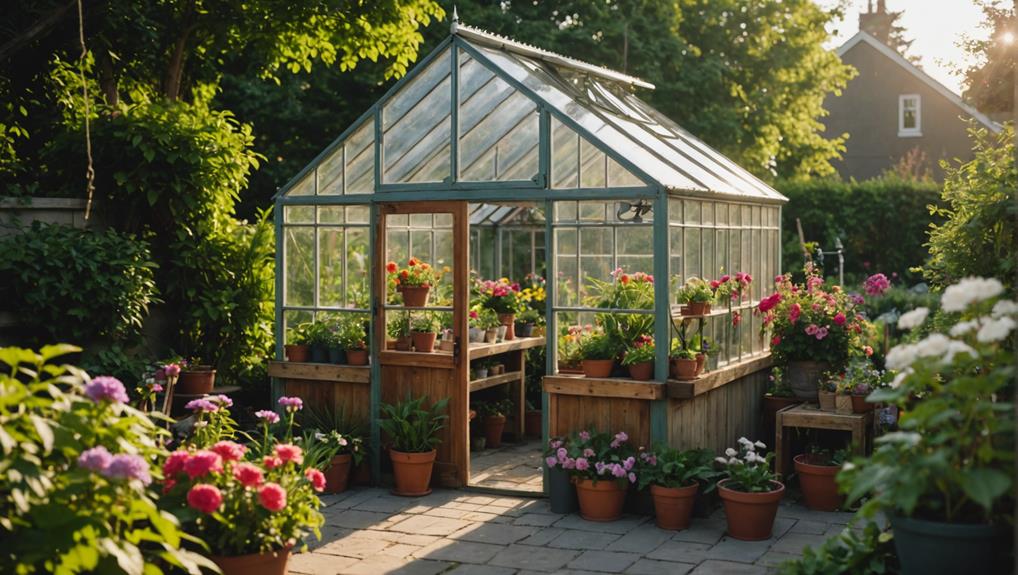
Designing your greenhouse involves blending functionality with your personal gardening goals, ensuring it meets your needs throughout the seasons. Start by exploring various types of greenhouses, such as the walipini style or a traditional design with a convertible top for seasonal adaptability. Aim for an ideal footprint of 9-by-16 feet, and a height of 6 feet, 6 inches, to maximize your growing space without overwhelming your garden.
For effective greenhouse design, position it with south-facing glazing to capture maximum solar energy, and consider adding thermal mass materials—like water barrels or bricks—to help regulate temperature. Insulating the north side can prevent heat loss and improve overall efficiency. You might also think about solar panels to harness renewable energy, creating a self-sufficient space.
Selecting durable materials, like triple wall polycarbonate for covering, enhances insulation while a wooden frame adds aesthetic appeal. Don't forget features like an internal gutter system for rainwater collection and pathways dug down 12-18 inches, which improve soil quality and air circulation. This way, you'll cultivate a thriving environment for your plants all year round.
Groundwork and Foundation Preparation
Before you start building your greenhouse, you'll need to focus on site selection and foundation preparation. Consider factors like sunlight exposure and drainage to guarantee your plants thrive. Choosing the right foundation type and digging pathways properly will set the stage for a successful gardening experience.
Site Selection Criteria
Selecting the right site for your greenhouse is vital for maximizing sunlight exposure and guaranteeing ideal plant growth throughout the year. Start by choosing a south-facing location; this position will assure at least six hours of direct sunlight daily, which is essential, especially in cold climates. To pinpoint the best spot, conduct seasonal solar mapping and utilize digital photography to track sunlight and shade patterns.
Once you've identified your site, level the area for a solid greenhouse structure and clear pathways. Dig down 12-18 inches for pathways to enhance airflow and protect your plants. Consider adding a stone foundation that elevates your greenhouse by six inches; this improves drainage and prevents water accumulation, which can harm your plants.
When planning the layout, confirm the door placement accounts for prevailing wind direction. This small detail can greatly reduce drafts and minimize heat loss, helping maintain a consistent environment for your plants. By carefully considering these site selection criteria, you'll create a prime setting for your greenhouse, allowing you the freedom to grow year-round.
Foundation Types Overview
Understanding the different foundation types is essential for ensuring your greenhouse remains stable and functional throughout the seasons. You have options that cater to your needs and environment. A stone foundation is a solid choice, elevating your greenhouse by 6 inches, which enhances drainage and protects against moisture. If you're in a location without a formal foundation, simply leveling the ground and adding a layer of topsoil can create a stable base.
If you choose a wooden foundation, make sure to use pressure-treated timber. This prevents rot and extends the life of your structure, especially in damp conditions. It's also vital to place your foundation below the frost line if you live in colder areas. This step helps avoid issues caused by ground freezing and thawing cycles, which can compromise your greenhouse's stability.
Pathway Digging Techniques
After establishing a solid foundation for your greenhouse, focusing on pathway digging techniques is key to enhancing both plant protection and air circulation within the structure. By digging pathways to a depth of 12-18 inches, you improve soil circulation and create an effective drainage system. Here's a quick guide to keep in mind:
| Technique | Benefit |
|---|---|
| Level the ground | Guarantees stability and proper drainage |
| Use excavated soil | Create raised garden beds for better soil quality |
| Incorporate drainage pipe | Prevents water accumulation, protecting plant roots |
| Compact the soil | Provides a solid base, reducing settling over time |
As you dig, remember to use the soil you've removed to build raised beds, enriching them with compost. This not only enhances your garden's productivity but also promotes healthy growth. With these techniques, you'll create pathways that not only serve a functional purpose but also contribute to the overall health of your greenhouse environment. Enjoy the freedom of nurturing your plants year-round in a well-structured space!
Insulation and Thermal Management
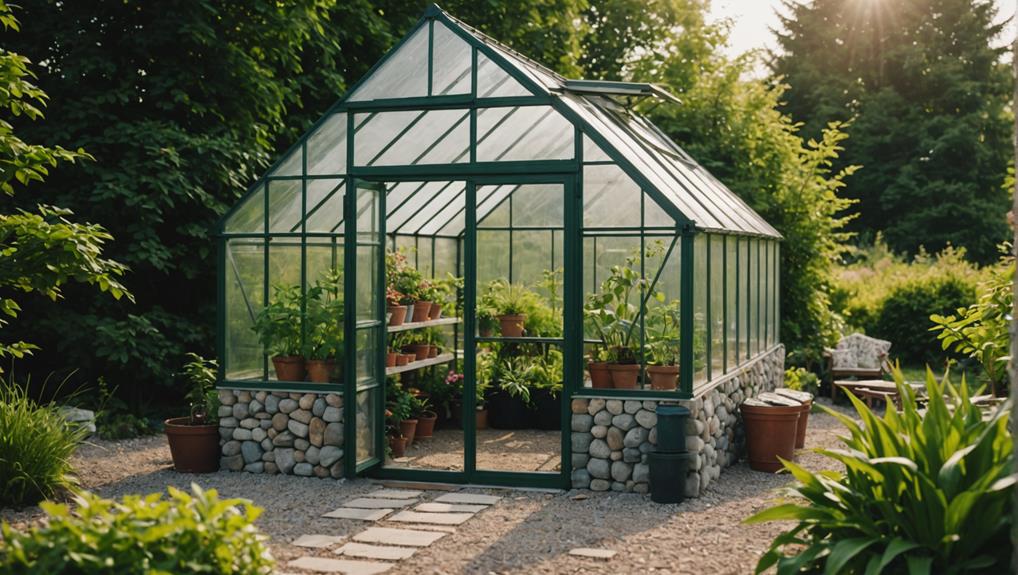
Insulating your greenhouse is essential for maintaining a stable temperature and reducing heat loss, especially during the colder months. You want your plants to thrive, and proper insulation helps you achieve that. Start by fully insulating the North wall to combat heat loss. Ground insulation is also key; it reduces heat loss through the floor and creates a thermal buffer against cold ground temperatures.
Consider using recycled materials like bubble wrap, foam insulation panels, or old blankets. They can effectively minimize heat loss and keep your greenhouse cozy in winter. Additionally, connecting your greenhouse to underground thermal mass, such as soil, can help stabilize temperature fluctuations. The soil acts as a thermal battery, storing and releasing heat slowly, which is perfect for your plants' needs.
If you're looking for even more thermal efficiency, think about partially burying your greenhouse. This approach utilizes the earth's natural insulation properties and shields your plants from extreme temperature variations. With these insulation and thermal management strategies, you can create a nurturing environment that allows you the freedom to garden year-round, no matter the weather outside.
Ventilation Strategies for Growth
Effective ventilation is essential for keeping your greenhouse cool and ensuring your plants thrive. You want to create an environment that promotes healthy growth while reducing the risk of molds and pests. Implementing smart ventilation strategies is key. Start by using natural convection: position your intake vents lower and your exhaust vents higher. This allows warm air to rise and escape while cooler air flows in, creating a steady airflow.
Roof vents are particularly effective in this setup, as they let hot air escape efficiently. You can also add side openings to enhance airflow throughout your greenhouse. For added convenience, consider automated vent systems, especially solar-powered options. They adjust automatically based on temperature, ensuring your plants always have the ideal conditions they need.
Maintaining Your Greenhouse
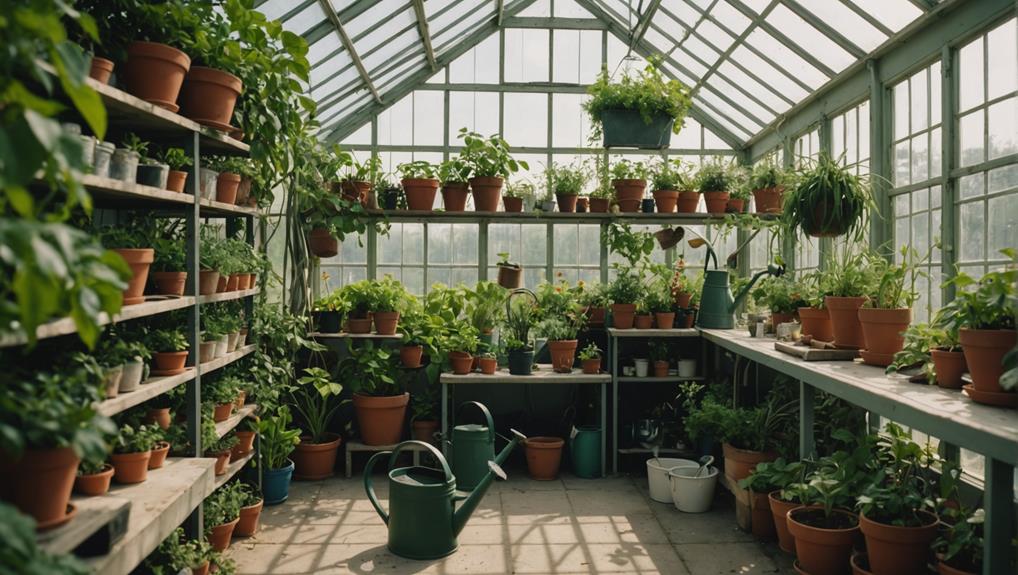
To keep your greenhouse thriving, you'll want to follow a seasonal maintenance checklist that covers everything from temperature monitoring to structural inspections. Regularly checking these factors helps prevent problems before they start, ensuring your plants stay healthy year-round. By staying proactive, you can create the ideal environment for your garden to flourish.
Seasonal Maintenance Checklist
Regular maintenance is essential for keeping your greenhouse in top shape, ensuring ideal growing conditions throughout the year. To help you out, here's a seasonal maintenance checklist to keep your clean greenhouse thriving:
| Task | Frequency |
|---|---|
| Clean glazing and vents | Pre-growing season |
| Inspect insulation | Winter |
| Remove dead plant material | Monthly |
| Adjust temperature and humidity levels | Weekly |
| Conduct seasonal soil management | Changeover periods |
Start by regularly checking and cleaning the greenhouse glazing and vents, especially before the growing season kicks off. This boosts light transmission and ventilation. Monitor temperature and humidity levels throughout the year, adjusting heating or ventilation as needed for peak growth conditions. In winter, inspect insulation materials to prevent heat loss, replacing any damaged sections.
Keeping your greenhouse clean is crucial—remove dead plant material, pests, and debris to foster a healthy environment. Finally, conduct seasonal soil management by mixing in compost or garden soil during changeovers to enhance soil quality and nutrient availability. Stay proactive, and your greenhouse will flourish!
Regular Temperature Monitoring
Keeping a close eye on temperature changes inside your greenhouse is essential for maintaining ideal growth conditions year-round. You should aim for 24-30°C during the day and 15-24°C at night in summer, while in winter, target 18-21°C during the day and 7°C at night. Regular temperature monitoring helps you identify when adjustments are needed, such as adding shading or heating solutions.
To enhance airflow and maintain stable temperatures, consider utilizing automated vent systems. These systems can automatically open or close based on the temperature you've recorded, guaranteeing your plants stay comfortable without constant manual adjustments.
Additionally, think about installing insulation materials like bubble wrap or foam panels. These can help retain heat during the colder months and reduce temperature fluctuations, allowing for a more consistent environment.
Lastly, make certain to assess and maintain your heating sources regularly. This way, you can ascertain they function correctly and provide supplemental warmth during extreme cold spells. By keeping an eye on these details, you'll create a thriving greenhouse that supports your gardening dreams year-round.
Frequently Asked Questions
How to Make a Greenhouse for All Year-Round?
To make a greenhouse for year-round use, consider ventilation systems and proper greenhouse materials. Focus on temperature control and choose frost-hardy plant selection to guarantee your garden thrives no matter the season. Enjoy your freedom to grow!
Can You Garden Year-Round in a Greenhouse?
Yes, you can garden year-round in a greenhouse. By selecting seasonal crops, ensuring proper greenhouse insulation, and maintaining temperature control, you'll enjoy the freedom of fresh produce, regardless of the weather outside.
How Do You Maintain a Year-Round Greenhouse?
To maintain a year-round greenhouse, you'll need effective ventilation systems, precise temperature control, and humidity regulation. Don't forget pest management techniques to keep your plants thriving and guarantee a healthy, vibrant growing environment.
Is It Cheaper to Build Your Own Greenhouse?
Building your own greenhouse can be cheaper, especially with careful cost analysis, material selection, and thoughtful design considerations. You'll enjoy long-term savings, plus the freedom to customize it to fit your gardening needs perfectly.
Conclusion
Building a DIY greenhouse can transform your gardening experience, allowing you to grow year-round. By choosing the right location, gathering essential materials, and implementing proper insulation and ventilation, you'll create an ideal environment for your plants. Don't forget to maintain your greenhouse regularly to guarantee it thrives. With a little effort and creativity, you'll enjoy fresh produce and beautiful blooms, no matter the season. Get started on your greenhouse project today, and watch your garden flourish!
As an Amazon Associate I earn from qualifying purchases.


